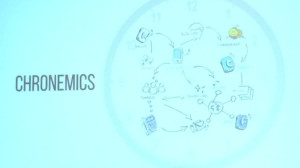One of the most complicated relationships that anybody has in their life is their relationship to time. Time requires constant management and must be constantly negotiated to make room for an endless parade of pursuits and tasks. Despite its paramount importance, there are many cultural assumptions about time that go unrecognized. At this year’s SXSW Interactive, organizational communication scholar Dawna Ballard delivered a session which brought these hidden features to light.
Ballard began her sessio n by making it clear that time in and of itself was not the subject of her discussion. What her research explores is chronemics, which she defined for the audience as the relationship between people and time. Her concern lies in not in time itself, but in how people experience it.
n by making it clear that time in and of itself was not the subject of her discussion. What her research explores is chronemics, which she defined for the audience as the relationship between people and time. Her concern lies in not in time itself, but in how people experience it.
She highlighted industrial time, which emerged alongside factory work, as a major player in shaping the contemporary relationship between people and time. Industrial time entailed people working alongside machines and being expected to take on one of their key characteristics: the ability to work at the desired level of productivity at any time.
The assumption that people are able to work like machines is one of the myths Ballard sought to topple in her presentation.
“Each hour on a clock looks quantitatively the same,” she said before highlighting the gap between the appearance and experience. “Within a given day there are better times to answer email.”
Another problem Ballard articulated is the failure of many people to account for the fact that the time allotted for any given task is often not experienced consecutively. This has major ramifications for productivity.
Saying that an individual had X number of hours to work on a project is often a deceptive statement because it does not recognize that contemporary work tends to be structured around interruption. Looking exclusively at the raw amount of time available means failing to recognize the mental labor that must be undertaken to toggle between the task at hand and the urgent emails that roll in during its completion.
Concepts of time have done a lot of work in shaping cultural concepts of work. The closing stretch of Ballard’s session focused heavily on myths about work that have been fed by misconceptions of time.
Work myths have been used to justify the often unreasonable expectations placed on workers. One persistent myth that Ballard discussed is the idea that if a person loves their work, it somehow becomes something other than work. Check out the video below to hear her speak on the problem with this way of thinking.
The final stretch of Ballard’s session was dedicated to dismantling a myth of incredible popularity: the myth of work-life balance.
“How many of you find it easy to extract what your life is from what your work is?” Ballard asked the audience. Nobody raised their hand.
She said that placing such a premium on work-life balance has the unintended side effect of becoming yet another standard to live up to. Striving for such balance can initiate a vicious cycle.
People often feel great pressure to work and be productive. They throw themselves into their work with vigor. Then they see their friend’s Instagram feeds and wonder why they never have the time to go out for brunch or spend a night on the town. When this happens, people begin to feel the need to prove, both to themselves and the world, that they do, in fact, have a life. Naturally, once this becomes the emphasis their work suffers and the cycle begins anew.
Ballard recommended replacing the notion of work-life balance with the idea of alignment. Alignment is a more open, less-defined term than work-life balance. It is a way of thought that recognizes that work and life cannot be compartmentalized so easily. Being aligned means not clinging to notions of what a balanced life looks like. An aligned person has found their center of gravity. They have worked out a system that works and is sustainable.
Alignment, Ballard said, is a safer proposition that balance. Balance is a high-wire act. If someone loses balance, they fall to the ground and reaching the height they fell from is no easy task. Taking the time to realign is far less treacherous.
